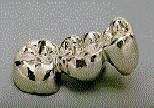
Why Gold?
GOLD! Doesn't that have a nice ring to it? Mention gold fillings and you immediately think of that elderly gentleman down the street with the twinkle in his smile. Gold inlays and fillings were very popular earlier on this century but have since been superceded by more aesthetic porcelain and composite restorations.
Gold restorations are made from gold alloyed with many other metals. The actual gold content can range from 90% to as low as 5%. Gold in its pure state is too soft to withstand the rigors of functioning in the mouth. Platinum or palladium are frequently added to harden the gold. There are some disadvantages. Both raise the already high melting point of the alloy. Platinum is expensive, palladium has been outlawed in some countries because it is toxic, and both turn the gold color to silver. Copper is added to restore the gold color, but it has a reddish tint, is toxic, and forms bubbles in the alloy. Silver can be added to get rid of the red color, and zinc is a toxic metal, but it is in small quantities and it will eliminate the air bubbles. The latter metals also reduce the melting temperature.
Why use gold at all? Well, from feedback from patients, the few people that choose gold for crowns, inlays or bridges have found that the "feel" of gold is very similar to that of natural tooth surface. Porcelain, although aesthetically superior can sometimes feel too "smooth" and "hard"). urprisingly, the cost of a gold crown or inlay is often similar to (or even less!) than that of a porcelain crown. This is due to the fact that a gold crown is easier to construct and the extra cost of gold is offset by the lesser amount of labour.
The image in the top right demonstrates a gold bridge!
LINKS | TOPICS ONLINE | SEARCH | HOME